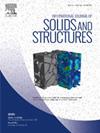Coupled longitudinal and transverse damage modeling of fiber-reinforced polymers using a smeared crack approach
IF 3.4
3区 工程技术
Q1 MECHANICS
International Journal of Solids and Structures
Pub Date : 2025-01-27
DOI:10.1016/j.ijsolstr.2025.113252
引用次数: 0
Abstract
Longitudinal damage, or fiber-dominated failures, is the principal contributor to the stiffness loss in multidirectional composite laminates. In this work, the 3D smeared crack model, previously developed for transverse damage in unidirectional fiber-reinforced polymer composites, is extended for the first time to include longitudinal tensile and compressive failure, considering fiber kinking using a continuum damage approach. This formulation is developed to facilitate the implementation in an implicit solver, increasing solution robustness and computational efficiency in quasi-static and long duration analyses. The smeared crack formulation is incorporated into the fiber kinking model and seamless coupled with the transverse damage evolution model to address combined loading modes and mixed mode loading. The performance of the model is evaluated using monotonic and non-monotonic damage evolution and verified with single element tests to demonstrate the consistency of the proposed formulation. Additional benchmark examples include open-hole tension and compression tests in multidirectional laminates, validated with experimental results, obtaining a good agreement in the predicted failure load, and correctly capturing the size effect.

基于涂抹裂纹方法的纤维增强聚合物纵向和横向耦合损伤建模
纵向损伤或纤维主导破坏是多向复合材料层合板刚度损失的主要原因。在这项工作中,之前开发的用于单向纤维增强聚合物复合材料横向损伤的3D涂抹裂纹模型首次扩展到包括纵向拉伸和压缩破坏,并使用连续损伤方法考虑纤维扭结。该公式的开发是为了方便在隐式求解器中实现,在准静态和长时间分析中增加解的鲁棒性和计算效率。将涂抹裂纹公式纳入纤维扭结模型,并与横向损伤演化模型无缝耦合,以解决组合加载模式和混合加载模式。利用单调和非单调损伤演化对模型的性能进行了评估,并通过单单元试验验证了该模型的一致性。其他基准示例包括多向层压板的裸眼拉伸和压缩测试,并与实验结果进行了验证,在预测破坏载荷方面获得了很好的一致性,并正确捕获了尺寸效应。
本文章由计算机程序翻译,如有差异,请以英文原文为准。
求助全文
约1分钟内获得全文
求助全文
来源期刊
CiteScore
6.70
自引率
8.30%
发文量
405
审稿时长
70 days
期刊介绍:
The International Journal of Solids and Structures has as its objective the publication and dissemination of original research in Mechanics of Solids and Structures as a field of Applied Science and Engineering. It fosters thus the exchange of ideas among workers in different parts of the world and also among workers who emphasize different aspects of the foundations and applications of the field.
Standing as it does at the cross-roads of Materials Science, Life Sciences, Mathematics, Physics and Engineering Design, the Mechanics of Solids and Structures is experiencing considerable growth as a result of recent technological advances. The Journal, by providing an international medium of communication, is encouraging this growth and is encompassing all aspects of the field from the more classical problems of structural analysis to mechanics of solids continually interacting with other media and including fracture, flow, wave propagation, heat transfer, thermal effects in solids, optimum design methods, model analysis, structural topology and numerical techniques. Interest extends to both inorganic and organic solids and structures.

 求助内容:
求助内容: 应助结果提醒方式:
应助结果提醒方式:


